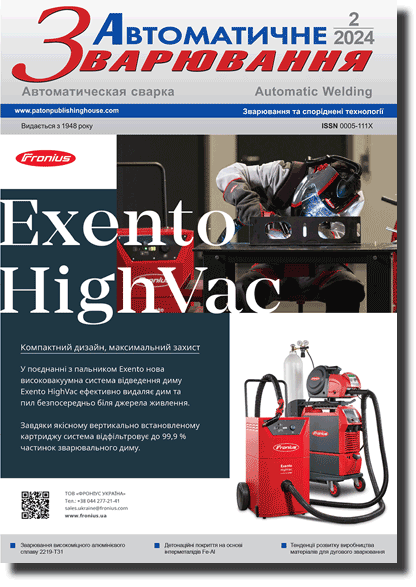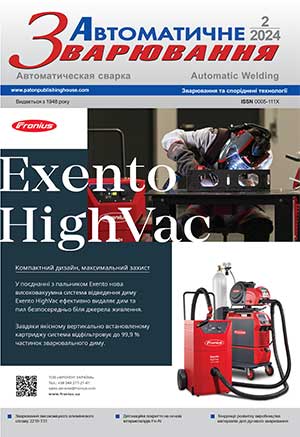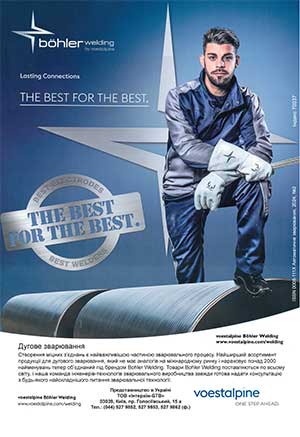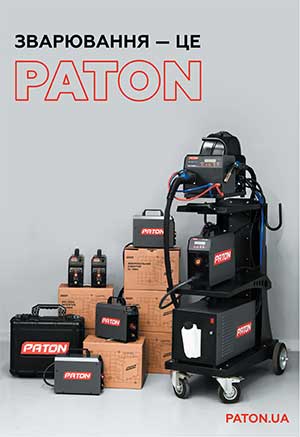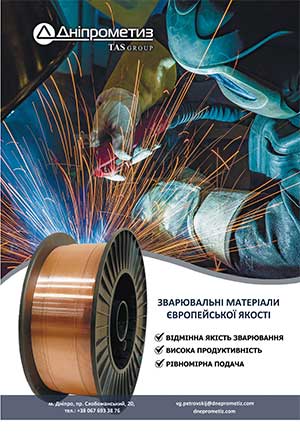| 2024 №02 (05) |
DOI of Article 10.37434/as2024.02.06 |
2024 №02 (07) |
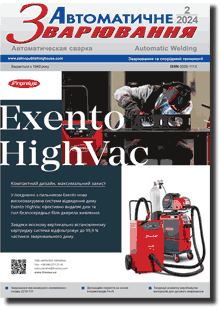
"Avtomatychne Zvaryuvannya" (Automatic Welding), #2, 2024, pp. 31-39
Influence of dispersed and chemical composition of welding aerosols on their toxicity
O.G. Levchenko1, Yu.O. Polukarov1, O.M. Goncharova2, O.M. Bezushko2, O.S. Ilchuk1
1NTUU «Kyiv Igor Sikorsky Polytechnic Institute». 37 Beresteisky Ave., 03056, Kyiv, Ukraine. E-mail: mail@kpi.ua2E.O. Paton Electric Welding Institute of the NAS of Ukraine 11 Kazymyr Malevych Str., 03150, Kyiv, Ukraine. E-mail: office@paton.kiev.ua
The aim of this review is to analyze the literature data on the impact of dispersive and chemical composition of welding aerosols on their toxicity for the further development of measures and means of protection of respiratory organs of welders. It is shown that the total toxic effect of welding aerosols depends on their chemical composition and the size of aerosol particles. Nanoparticles of welding aerosols can have completely different physicochemical properties and biological effects compared to substances in the normal physicochemical state. They belong to harmful substances with an increased potential risk to human health. Welding aerosols, getting into the body of the welder, cause toxic effects, resulting in various diseases of respiratory organs, nervous and circulatory systems, cancer diseases. Since it is impossible to completely remove welding aerosol from the welding zone, it is necessary to continue the study of their chemical and dispersed composition, levels of emissions and methods of reducing toxic effects. In the process of welding, the elements contained in welding materials are transferred in aerosol. Therefore, it is necessary to study the factors affecting an increase in the intensity of emissions and toxicity of welding aerosols. 41 Ref., 2 Tabl., 1 Fig.
Keywords: welding, aerosols, gases, sizes, nano-size particles, toxicity, recommendations
Received: 15.11.2023
Received in revised form: 24.11.2023
Accepted: 11.01.2024
References
1. Kashuba, M.O. (2006) Sedimentation capacity and penetrability of welding aerosols in separate areas of respiratory systems. Ukrainskyi Zh. z Problem Medytsyny Pratsi, 2, 17-22 [in Ukrainian]. https://doi.org/10.33573/ujoh2006.02.0172. Kundiev, Yu.I., Basanets, A.V. (2012) Pneumoconiosis: Emidemiology, early diagnostics, preventive measures. Avitsena, 191 [in Ukrainian].
3. Tanneberger, J.F.W.G. (2009) Schweiβrauch am Arbeitsplatz - Gefahr für die Gesundheit. Der Praktiker, 9, 328.
4. Jenkins, N.T., Pierce, W.M.G., Eagar, T.W. (2005) Particle size distribution of gas metal and flux cored arc welding fumes. Welding J., 84(10), 156-163.
5. Berlinger, B., Benker, N., Weinbruch, S. et al (2010) Physicochemical characterization of different welding aerosols. Anal Bioanal Chemistry, 10, 1773-1789. https://doi.org/10.1007/s00216-010-4185-7
6. Hoet, P.H.M., Bruеske-Hohlfeld, I., Salata, O.V. (2004) Nanoparticles - known and unknown health risks. J. of Nanobiotechnology.
7. Serdyuk, A.M., Kundiev, Yu.I., Trakhtenberg, I.M. et val. (2009) Nanotoxicology: Directions of investigations. Dovkillya ta Zdoroviya, 1 (48), 3-7 [in Ukrainian].
8. (2003) (2003) DSTU ISO 7708:2003. Air quality. Particle size fraction definitions for health-related sampling. No. 166, 02.10.2003 [in Ukrainian].
9. Lanovenko, O.G., Ostapishyna, O.O. (2013) Dictionaryhandbook of ecology. Training-methodological manual. PP Vyshemyrskyi V.S. [in Ukrainian].
10. Kalinchak, V.V., Chernenko, O.S., Kontush, S.M. et al. (2019) Physics of medical aerosols. Odesa Nats. Un-t [in Ukrainian].
11. Leonenko, N.S., Demetska, O.V., Leonenko, O.B. (2016) Peculiarities of physicochemical properties and toxic action of nanomaterials - to problem of evaluation of their hazardous effect on living organisms (Literature review). Current problems of toxicology, food and chemical safety. Ukr. Zh. Suchasnykh Problem Toksykologii, 1, 64-76 [in Ukrainian].
12. Vaskovets, L.A. (2022) Professional risks under impact of nanoparticles. In: Proc. of 14th Int. Sci.-Method. Conf. and 149th Sci. Conf. of Europ. Assoc. Safety (EAS), 1-2 December, 162-165.
13. Donaldson, K., Stone, V. (2003) Current hypotheses on the mechanisms of toxicity of ultrafine particles. Annali dell'Istituto superiore di sanitа, 39(3), 405-410.
14. Khanna, P., Ong, C., Bay, B.H., Baeg, G.H. (2015) Nanotoxicity: an interplay of oxidative stress, inflammation and cell death. Nanomaterials, 5(3), 1163-1180. https://doi.org/10.3390/nano5031163. https://doi.org/10.3390/nano5031163
15. Knaapen, A.M., Borm, P. ., Albrecht, C., Schins, R.P. (2004) Inhaled particles and lung cancer. Part A: Mechanisms. International journal of cancer, 109(6), 799-809. https://doi.org/10.1002/ijc.11708
16. Risom, L., Møller, P., Loft, S. (2005) Oxidative stress-induced DNA damage by particulate air pollution. Mutation Research/Fundamental and Molecular Mechanisms of Mutagenesis, 592(1-2), 119-137. https://doi.org/10.1016/j.mrfmmm.2005.06.012
17. Jiang, J., Oberdörster, G., Elder, A. et al. (2008) Does nanoparticle activity depend upon size and crystal phase. Nanotoxicology, 2(1), 33-42. https://doi.org/10.1080/17435390701882478
18. Lu, N., Zhu, Z., Zhao, X. et al. (2008) Nano titanium dioxide photocatalytic protein tyrosine nitration: a potential hazard of TiO2 on skin. Biochemical and biophysical research communications, 370(4), 675-680. https://doi.org/10.1016/j.bbrc.2008.04.010
19. Lewinski, N., Colvin, V., Drezek, R. (2008) Cytotoxicity of nanoparticles. Small, 4(1), 26-49. https://doi.org/10.1002/smll.200700595
20. Shatorna, V.F., Garets, V.I., Krutenko, V.V. et al. (2012) Nanomaterials: State-of-the-art of current investigations and application in biology, medicine and veterinary science (Literature review). Visnyk Problem Biologii i Medycyny, 3(2), 29-32
21. Tong, T., Wilke, C.M., Wu, J. et al. (2015) Combined toxicity of nano-ZnO and nano-TiO2: from single-to multinanomaterial systems. Environmental science & technology, 49(13), 8113-8123. https://doi.org/10.1021/acs.est.5b02148
22. Minigalieva, I.A., Katsnelson, B.A., Privalova, L.I. et al. (2015) Attenuation of combined nickel (II) oxide and manganese (II, III) oxide nanoparticles' adverse effects with a complex of bioprotectors. International journal of molecular sciences, 16(9), 22555-22583. https://doi.org/10.3390/ijms160922555
23. Renwick, L.C., Donaldson, K., Clouter, A. (2001) Impairment of alveolar macrophage phagocytosis by ultrafine particles. Toxicology and applied pharmacology, 172(2), 119-127. https://doi.org/10.1006/taap.2001.9128
24. Renwick, L.C., Brown, D., Clouter, A., Donaldson, K. (2004) Increased inflammation and altered macrophage chemotactic responses caused by two ultrafine particle types. Occupational and Environmental Medicine, 61(5), 442-447. https://doi.org/10.1136/oem.2003.008227
25. Nemmar, A., Hoet, P.M., Vanquickenborne, B. et al. (2002) Passage of inhaled particles into the blood circulation in humans. Circulation, 105(4), 411-414. https://doi.org/10.1161/hc0402.104118
26. Shvedova, A.A., Kisin, E.R., Mercer, R. et al. (2005) Unusual inflammatory and fibrogenic pulmonary responses to single-walled carbon nanotubes in mice. American Journal of Physiology-Lung Cellular and Molecular Physiology, 289(5), 698-708. https://doi.org/10.1152/ajplung.00084.2005
27. Bahadar, H., Maqbool, F., Niaz, K., Abdollahi, M. (2016) Toxicity of nanoparticles and an overview of current experimental models. Iranian biomedical journal, 20(1), 1. https://doi.org/10.7508%2Fibj.2016.01.001
28. Zhu, M.T., Feng, W.Y., Wang, B. et al. (2008) Comparative study of pulmonary responses to nano-and submicron-sized ferric oxide in rats. Toxicology, 247(2-3), 102-111. https://doi.org/10.1016/j.tox.2008.02.011
29. Naqvi, S., Samim, M., Abdin, M.Z. et al. (2022) Concentration- Dependent Toxicity of Iron Oxide Nanoparticles Mediated by Increased Oxidative Stress [Retraction]. International Journal of Nanomedicine, 17, 1459-1460. https://doi.org/10.2147/IJN.S367448
30. Albukhaty, S., Naderi-Manesh, H., Tiraihi, T. (2013) In vitro labeling of neural stem cells with poly-L-lysine coated super paramagnetic nanoparticles for green fluorescent protein transfection. Iranian biomedical journal, 17(2), 71.
31. Chen, Z., Meng, H., Xing, G. et al. (2006) Acute toxicological effects of copper nanoparticles in vivo. Toxicology letters, 163(2), 109-120. https://doi.org/10.1016/j.toxlet.2005.10.003
32. Levchenko, O.G., Lukianenko, A.O., Demetska, O.V., Arlamov, O.Yu. (2018) Influence of Composition of Binder of Electrodes Coating on Cytotoxicity of Welding Aerosols. In Materials Science Forum. Trans Tech Publications, 927, 86- 92. https://doi.org/10.4028/www.scientific.net/MSF.927.86
33. Levchenko, O., Demetska, O., Polukarov, Y. et al. (2023) Identifying patterns of aerosols formation during contact butt fusion welding. Eastern-European Journal of Enterprise Technologies, 3(10 (123), 30-38. https://doi.org/10.15587/1729-4061.2023.281011
34. Kundiev, Yu.I., Korda, M.M., Kashuba, M.O., Demetska, O.V. (2015) Toxicology of aerosols: Monography. TDMU Ukrmedknyga [in Ukrainian].
35. Levchenko, O.G. (2015) Welding aerosols and gases: Processes of formation, methods of neutralization and security facilities. Kyiv, Naukova Dumka [in Russian]. https://doi.org/10.15407/tpwj2015.07.04
36. (2006) Exposition au manganese: l'llW se pronounce. Actualites profession. Hygiene du travail. Soudage et techniques connexes, 11/12, 15.
37. (2006) Fumees de soudage: valeurs limites, evaluation des risques, mesures de prevention. Etudes et recherche. Hygiene et securite. Soudage et techniques connexes, 7/8, 31-33.
38. Pohlmann, G., Holzinger, K., Spiegel-Ciobanu, V.E. (2012) Vergleichende Untersuchungen zur Charakterisierung ultrafeiner Partikel in Rauchen beim Schweißen und bei verwandten Verfahren-Teil 2: Ergebnisse und Diskussion. Schweißen und Schneiden, 64(6), 352.
39. Matusiak, J., Wyciślik, J. (2009) Zdrowie i bezpieczeństwo przy produkcji spawalniczej. Biuletyn Instytutu Spawalnictwa w Gliwicach, 53(3), 24-35.
40. (2020) Hygienic regulations of chemical substances in air of working area. Order of MOH of Ukraine No. 1596, 14.07.2020.
41. (2008) DSTU ISO 15011-4:2008. Health and safety in welding and allied processes. Laboratory method for sampling aerosols and gases. Pt 4: Form for recording data on aerosols. Kyiv, Derzhspozhyvstandart of Ukraine. Order No. 490, 22.12.2008 [in Ukrainian].
Advertising in this issue:
The cost of subscription/purchase order journals or individual articles
| Journal/Currency | Annual Set | 1 issue printed |
1 issue |
one article |
| TPWJ/USD | 384 $ | 32 $ | 26 $ | 13 $ |
| TPWJ/EUR | 348 € | 29 € | 24 € | 12 € |
| TPWJ/UAH | 7200 UAH | 600 UAH | 600 UAH | 280 UAH |
| AS/UAH | 1800 UAH | 300 UAH | 300 UAH | 150 UAH |
| AS/USD | 192 $ | 32 $ | 26 $ | 13 $ |
| AS/EUR | 180 € | 30 € | 25 € | 12 € |
| SEM/UAH | 1200 UAH | 300 UAH | 300 UAH | 150 UAH |
| SEM/USD | 128 $ | 32 $ | 26 $ | 13 $ |
| SEM/EUR | 120 € | 30 € | 25 € | 12 € |
| TDNK/UAH | 1200 UAH | 300 UAH | 300 UAH | 150 UAH |
| TDNK/USD | 128 $ | 32 $ | 26 $ | 13 $ |
| TDNK/EUR | 120 € | 30 € | 25 € | 15 € |
AS = «Automatic Welding» - 6 issues per year;
TPWJ = «PATON WELDING JOURNAL» - 12 issues per year;
SEM = «Electrometallurgy Today» - 4 issues per year;
TDNK = «Technical Diagnostics and Non-Destructive Testing» - 4 issues per year.





